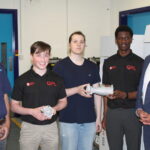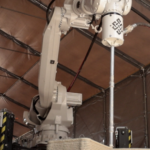Researchers from the Chinese University of Hong Kong have now developed a digital holography-based TPL (two-photon lithography) platform that enables parallel printing of complex 3D structures with 90 nm resolution at a rate of 2,000,000 voxels/sec.
Fast Nanostructures
Fabricating high-resolution complex 3D nanostructures is essential for many applications in nanotechnology. However, the low writing speed and high cost of the most effective nanoscale 3D printing technique (two-photon lithography), have limited its use in large-scale applications.
The new TPL platform utilizes a femtosecond (fs) regenerative laser amplifier that supports parallel writing with up to 2000 hologram-generated laser foci. All laser foci can be individually controlled in terms of amplitude, phase, and location. A custom photoresist is developed to work with the ultrahigh-peak-power light source.
The optical configuration of the multi-focus TPL system consists of a digital micro-mirror device (DMD) that displays designed holograms, which generate laser foci on the Fourier plane. You can see an illustration of the apparatus in the graphic below, along with some images of printed polymer nanostructures.

In particular, the researchers have investigated the kinetic factors that determine the quality of printing, such as the diffusion and solidification processes, to optimize the system. The TPL system was able to achieve a volume printing speed of up to 54.0 mm3/h, and a resolution of 90 and 141 nm in lateral and axial directions, respectively.
With this setup, they have been able to fabricate a variety of nanostructures including magnetic micro-gears, 2D diffractive surfaces, and more.
Trade-off
In additive manufacturing there is typically a trade-off between resolution and printing speed – higher resolutions are slower to print, and normally printing at higher speeds involves a loss of resolution, especially at smaller voxel scales.

The single-pulse exposure strategy in this process breaks the trade-offs between resolution and rate as the single-pulse strategy minimizes the influence of diffusion and prevents unwanted voxel expansion, allowing for better control of structure formation. As the number of laser pulses increases, the structures can become rougher and more distorted.
In the single-pulse printing process used by the researchers, multiphoton absorption is the dominant mechanism of polymerization which enables the printing of high-resolution features while maintaining an efficient printing rate.
Future Applications
Overall, the multi-focus TPL platform has achieved unparalleled results in resolution, scanning flexibility, grayscale control, and fabrication rates compared to other parallel TPL solutions. Enabled by the unique photopolymerization kinetics, an fs laser amplifier, a custom-designed photoresist, and a holography-based DMD scanner, this platform can offer improved speed, precision, and reduced cost.
This technique has the potential to revolutionize the fabrication of functional nano- and micro-structures at a large scale, opening up new opportunities in various fields such as photonics, flexible electronics, material sciences, mechanics, biomedicine, and micro-robotics.
You can read the research paper titled “Ultrafast 3D nanofabrication via digital holography”, published in Nature Communications, over at this link.
Come and let us know your thoughts on our Facebook, Twitter, and LinkedIn pages, and don’t forget to sign up for our weekly additive manufacturing newsletter to get all the latest stories delivered right to your inbox.









